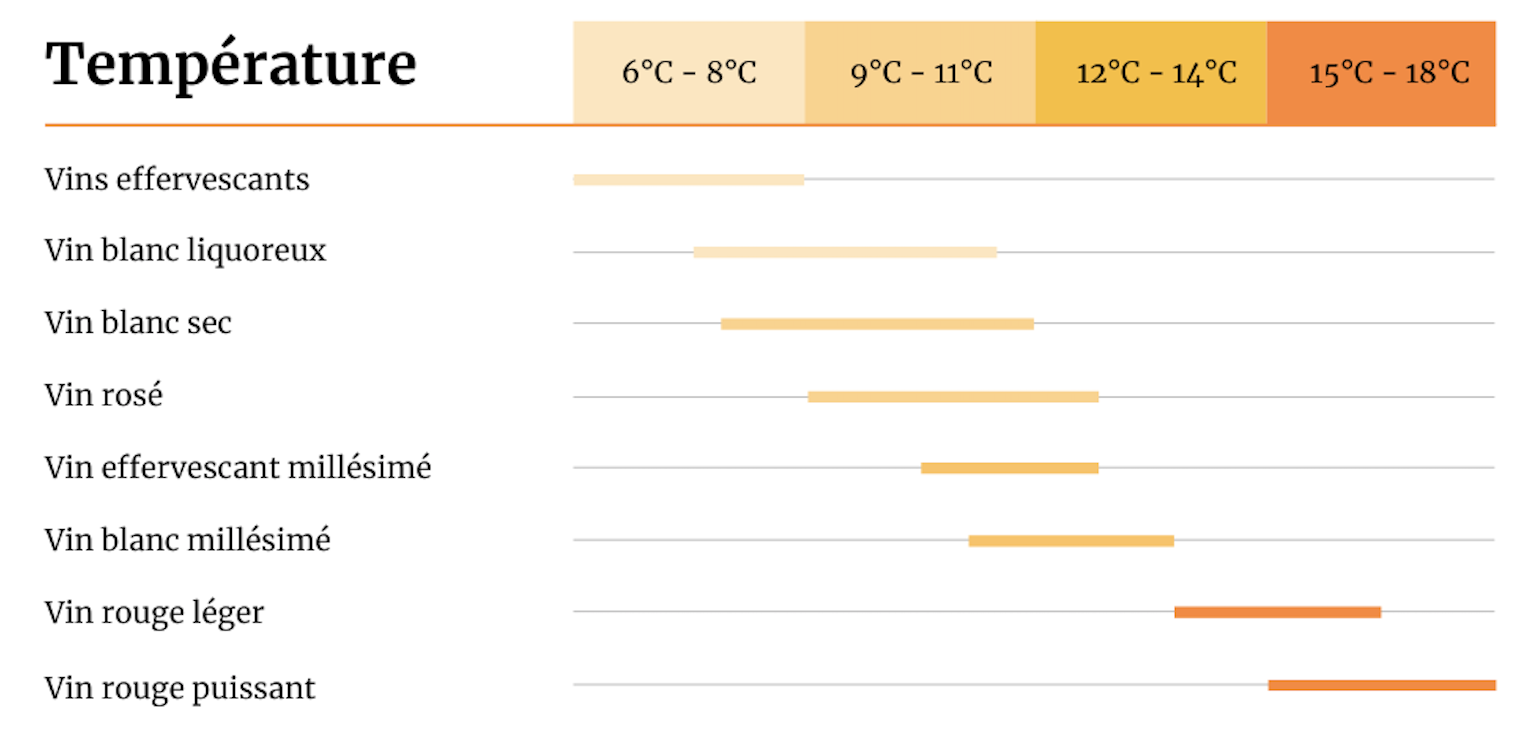Let's take a closer look at why chilled white wine is an essential choice, and how to optimize its service for the perfect tasting experience.
The impact of temperature on white wine flavors
Temperature has a direct influence on the perception of a wine's aromas and structure. A white wine served too warm may seem heavy and unbalanced, while one served too cold may lose expressiveness.
- Aromas and freshness
- Lowering the temperature of the white wine service preserves the liveliness of the aromas.
- Fresh white wines release their fruity and floral notes best when served between 8 and 12°C.
- A white wine that is too warm can seem alcoholic and lose its subtle nuances.
- Acidity and structure
- The cold accentuates the sensation of freshness and the wine's natural acidity.
- It preserves the balance between sugar and acidity, especially for dry, lively white wines.
- Good temperature management enhances the wine's lightness and elegance.
- Alcohol and tannins
- Unlike reds, white wines have little or no tannin.
- Too high a temperature brings out the perception of alcohol.
- Serving a chilled white wine softens the mouthfeel and harmonizes the flavors.
Why are red wines served warmer?
Unlike white wines, reds have a more pronounced tannic structure. These tannins need a higher temperature to fully express themselves.
- A red wine that is too cold will have harder tannins and too much astringency.
- A fresh white wine benefits from a low temperature, which enhances its natural freshness.
- However, light reds can be served slightly chilled, around 14°C, to accentuate their fruitiness.
At what temperature should each type of white wine be served?
Each category of white wine has its own ideal temperature for revealing its characteristics.
- Dry, lively white wines (Sauvignon Blanc, Albariño, dry Riesling): between 8 and 12°C.
- Aromatic white wines (Viognier, Gewurztraminer, Muscat): between 7 and 11°C.
- Full-bodied, oaky white wines (Chardonnay, barrel-aged Semillon): between 12 and 14°C.
- Sweet and syrupy wines (Sauternes, Monbazillac, Tokaji): between 6 and 8°C.
Respecting these temperature ranges guarantees optimal tasting and brings out the best in white wine flavors.

How to refresh white wine effectively?
There are several ways to reach the ideal white wine service temperature:
- Using an ice bucket
- Place the bottle in a mixture of water and ice for 15 to 20 minutes.
- This method is quicker than leaving it in the fridge.
- Refrigerate in advance
- A white wine should be placed in the refrigerator 3 to 4 hours before serving.
- Avoid leaving it too long, or it will lose its aromas.
- Express cooling
- Wrap the bottle in a damp cloth and place in the freezer for 15 minutes.
- Don't forget the bottle to prevent it from freezing.
- Stainless steel ice cubes
- They allow wine to cool rapidly without dilution.
- A practical solution for adjusting temperature during tasting.
Mistakes to avoid when serving white wine
- Serving white wine too cold
- Below 6°C, the wine becomes neutral and its aromas disappear.
- The mouth contracts and the taste experience is less pleasant.
- Letting a white wine warm up too quickly
- Once served, a white wine warms up quickly in the glass.
- It is advisable not to pour large quantities at a time.
- Using unsuitable glass
- A glass that's too small doesn't allow the aromas to express themselves fully.
- Choose a stemmed glass, slightly narrower at the top to concentrate the aromas.
What dishes go best with a chilled white wine?
White wine is an excellent partner for many dishes:
- Seafood and fish: a Sauvignon Blanc or Muscadet for a perfect match.
- White meats and poultry: a lightly oaked Chardonnay for greater roundness.
- Goat's cheese: a Sancerre or Pouilly-Fumé for a balanced match.
- Spicy Asian dishes: a Gewurztraminer to soften the heat of the spices.
Choosing a chilled white wine to match the dish enriches the gastronomic experience.
Should I decant a white wine?
Unlike red wines, few whites require prolonged aeration. However, some structured white wines can benefit from light decanting.
- Young, aromatic wines are best served immediately after opening.
- Great oaky white wines can be decanted for 15 to 30 minutes to soften their aromas.
It's best to gradually test the wine's openness before decanting for too long.
Conclusion
The temperature at which a white wine is served plays a key role in the perception of aromas and the balance of flavors. Serving a white wine chilled enhances its liveliness, acidity and fruity aromas.
Adapting the temperature to each type of wine and avoiding common mistakes guarantees successful tasting.
If you enjoyed this article, please read the following article "How to organize a wine cellar dedicated to spirits and fortifiedwines", which may also be of interest to you!





